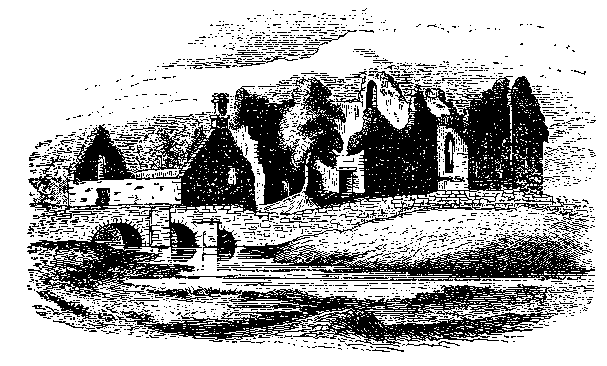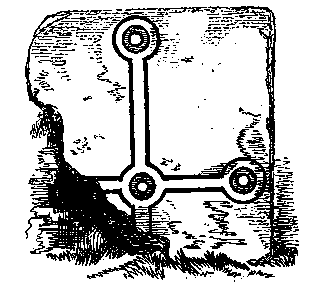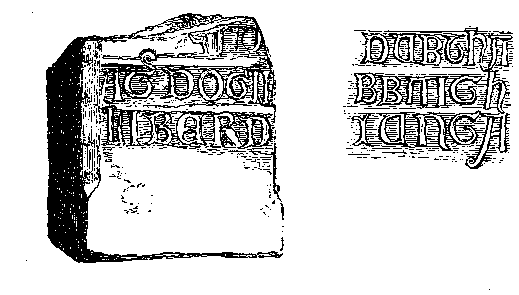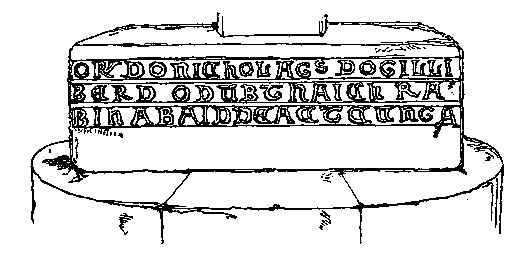Chapter 7: Cunga Fheichín (Cong)
Return to table of contents
Refer to Map
The ruins of Cong church and monastery occupy the south-western angle of the island, but have become so mixed up with modern buildings, that it is now difficult to find a point of view from which to give a good representation of the entire.Our chapter headpiece made many years ago by Samuel Lover, R.H.A., from a point somewhat to the north-east of the bridge of the Cillín Breac, very truthfully represents the scene.
Among the splendid ecclesiastical remains of Cong, the twelfth century advocates may revel, and defy us to prove an earlier date for their erection than that of the introduction of the Augustinian Order into Ireland, even if their ornamentation and design did not afford ample data for judging their age.
These ruins would scarcely have held together to the present day, had not Sir B. L. Guinness restored several of the dilapidations, cleared out much of the rubbish which had accumulated within and around them, and rendered the burial ground sufficiently decent for the interment of Christian people.[fn84-1]

We enter the abbey from the village by a very beautiful doorway,
which, although it has been often figured, we would here present to
our readers, but that we know it is of the "composite order," having
been made up some years ago of stones taken from another arch in this
northern wall. Within it, we find ourselves in the great abbey church,
one
But, although Roderick himself was not buried here others of his name and lineage were. Thus we read that in 1224, "Maurice the Canon, son of Roderick O Conor --the most illustrious of the Irish for learning, psalm-singing and poetical compositions, died--and was interred at Cong." It is probably his tomb which is pointed out as that of the king. "A.D. 1226, Nuala, daughter of Roderick O'Conor, and Queen of Ulidia, died at Cunga Feichín, and was honourably interred in the church of the canons." [fn85-1] And in 1274, Finnuala, daughter of King Roderick, died at, and was probably buried at Cong. But although the dust of the last monarch is not beneath our feet, that of chieftains, warriors, and prelates remains and especially that of the abbots, down to the days of James Lynch, whose decorated tomb is dated 1703; and even later, for the Rev. Patrick Prendergast who was always styled "The Lord Abbot," was interred here in 1829. [fn85-2]
Several of these ecclesiastical flags are decorated with crosses, fleur-de-lis, chalices, and ornate croziers, etc.; and here are a few Latin inscriptions in raised letters, but with one exception no Irish writing can be discerned anywhere within the confines of the abbey. In the south wall there is a recess, with a circular arch, probably the tomb of the founder, or some munificent endower; there are also in this south wall piscinae, and other minor details of church architecture, unnecessary to describe; and lower down the same side is the small chapel-tomb of the Berminghams, once so powerful in Ireland, and who so identified themselves with their adopted country, that they dropped the Norman name, and assumed that of Mac Feorais.They became Lords of Athenry, and acquired great possessions in Connacht.[fn86-1]

During the clearances recently made, a few objects of interest were discovered, and among them a stone, bearing portion of an incised cross (see page 78 ). It is too narrow to have been a monumental flag, the longest arm of the cross being but thirteen inches; it was probably one of the terminal crosses that marked the boundaries of the ancient sacred enclosure.
Another stone of still greater interest, discovered in making these
restorations, is the quadrangular fragment of the shaft of an ancient
cross, which in all probability is a portion of the village cross
referred to at page 94; for not only does it bear the same names as
those on the base of the latter, but it accurately fits the mortise in
that plinth, being sixteen inches by eight. This stone,
 now about two feet high, and the two inscribed faces of which upon
opposite sides are here figured, is at present placed in the east
window.
now about two feet high, and the two inscribed faces of which upon
opposite sides are here figured, is at present placed in the east
window.
The inscription, which is in ancient raised letters, means--A prayer for Nichol and Gillebard O Dubthaigh, or O'Duffy, who were abbots of Cong; but which inscription is more perfect on the plinth of the market cross, figured and discribed at page 94.
The O'Duffys were distinguished ecclesiastics in this locality, and the Annals contain many entries concerning them. Thus we read that in "A.D. 1150 Muireadhach Ua Dubhthaigh, Archbishop of Connacht, chief senior of all Ireland in wisdom, in chastity, in the bestowal of jewels and food, died at Cunga on the 16th of the month of May, on the festival of St. Brénainn, in the 75th year of his age." His name is inscribed on the great processional "Cross of Cong," made in 1123. --See page 100.
"A.D. 1168, Flannagán Ua Dubhthaigh, bishop and chief doctor of the Irish in literature, history, and poetry, and in every kind of science known to man in his time, died in the bed of Muireadhach Ua Dubhthaigh, at Cunga."--See page 100.
Cadhla or Catholicus O Duffy, and several of the name, attained to the see of Tuam; in 1136, we read of the death at Clonfert, of Donnell O Duffy, "Archbishop of Connacht and successor of Cíarán, head of the wisdom and piety of the province"; and Cellach O Duffy was Bishop of "Mayo of the Saxons" in 1209.But none of these died abbots of Cong, and the only Abbot of the name referred to in the Annals is the one described by the Four Masters in the following quotation, under the year 1223: Dubhthach ua dubhthaigh abb Conga decc. "Duffagh O Duffy, Abbot of Cong, died." As to who this "Gillibard" or Gilla-Bard was, we have no clue from an examination of the Annals, and cannot, therefore, state when his death occurred; but it must have been subsequent to that of Duffagh and Nichol; and was probably in the beginning of the thirteenth century.
Before leaving this church and its crosses, let us perform an act of
partial expiation, by introducing to the visitor the following
illustration, showing the four decorated sides of a portion of the
shaft of a very beautiful sandstone cross, which was abstracted
from these ruins many years ago, but is still in existence. [fn89-1]
The two end portions of the illustration represent the sides; the
left-hand middle is the front, and the right the back, which latter
is countersunk, evidently for the insertion of a metal place,
which was probably inscribed with the name of the person who
 erected it, or to whose memory it was raised.The top is mortised for
the reception of the tenon of the upper portion of the shaft.
erected it, or to whose memory it was raised.The top is mortised for
the reception of the tenon of the upper portion of the shaft.
The original plan of this abbey is not easily made out at present.
Through an arched doorway in the southern
wall we pass into a low vaulted apartment, and thence into a large
open space containing the principal stairs, which lead up to the
second story of the great tower, the upper portion of which, however,
no longer exists.The space to the east and south of this, which was
formerly occupied by the monastery, is now a graveyard, and the site
of the Roman Catholic chapel, and is divided by a
 high screen wall, the western facade of which forms the present great
architectural feature of this splendid pile, and is well shown in the
above illustration. It measures
high screen wall, the western facade of which forms the present great
architectural feature of this splendid pile, and is well shown in the
above illustration. It measures
Standing between the river and the abbey, the picture naturally rises ....
Passing under an arch, and over a bridge constructed of immense flagstones taken from the river's bed, we pass into Ashford, the demesne of Sir B. L. Guinness, the view of whose residence is figured overleaf. Let another describe it, and its environs. "Whether," says Sir Bernard Burke, in alluding to Cong, "you consider its unbounded fertility, the varied beauties of its surface, or the historical events which invest every plain and every mountain with an interest peculiarly its own, it stands forth to the lover of the wild and the beautiful, to the antiquarian and the geologist as unsurpassed by any portion of the British Empire.And we do not hesitate to insist that in this island, so favoured, the ancient town and neighbourhood of Cong are pre-eminent; in each of the particulars above alluded to, this portion of the counties of Galway and Mayo is unrivalled in its peculiarities.It presents a varied surface of contradictory elements--streams of barrenness and fertility, exquisite beauty and wild desolation; green valleys and rocky plains, lakes and rivers, and huge mountains, are so thrown together in wild confusion, that it would almost seem as if nature had wandered here in one of her sportive moods, producing on every side such a marvellous contrast and variety.It is in the loveliest part of this district that the property is situated, of which we have engaged to furnish a few particulars.Ashford, formerly a residence of lord Oranmore, occupies one of the most striking and beautiful sites in the whole island; and is situated on the right bank of the river, which, flowing past the ruins of the ancient abbey of Cong, is adorned in its short course with all that can constitute the interesting and picturesque.The writer well remembers this mansion, now comfortable, a dilapidated building, in the midst of a neglected domain--a very picture of poor Ireland herself when stricken by famine and pestilence.It was built by one of the family of Brown, early in the eighteenth century, somewhat in the style of the French chateau.The situation was well chosen; and the founder made it an exception to the almost general rule, that Irish mansions are erected near to, but not upon, the most eligible spots. The river, the lake, the deep and solemn woods that environ it, the extreme fertility of the domain --encircled as it were by a framework of bare rocks and interminable waters--constitute a species of oasis in this wild district, at once lovely, striking, and peculiar."
Within the demesne, and in the immediate vicinity of the handsome tower recently erected here, and shown in the foregoing illustration, there can'be seen one of those artificial caves formed by the ancient Fir Bolgs, or Tuatha Dé Danann, to which we shall have occasion to refer hereafter; but, as it is so nigh at hand, the visitor should inspect it now.This cave, called Lisín Árd, "the small high fort," which is sunk within an ancient circular rath, now surrounded with aged hazels, measures twenty-seven feet from its eastern entrance to its turn to the south, which latter portion is twenty-four long.Its average height is six and a half feet; and it is roofed with immense flags, supported on projecting corbels.There is also here a natural grotto, called Teach Aille, "the house of the cliff," where the waters of Loch Measca present themselves externally in their transit through the various north-western pools and caverns to Loch Coirib.Let us re-cross the river by Tóin a' Chaisleáin, "the bottom of the castle," or site of the old castle of Cong, which certainly existed in the days of Roderick O Flaherty, but the last fragment of which was removed about a hundred years ago, when "the circular road" of Cong was constructing.
Now, that we come prepared with historic knowledge, derived from our
visit to the abbey, let us inspect the Street or Market Cross, the
dark limestone plinth or base of which, with a carefully engraved
facsimile of its inscription, is here shown, the translation being: "A
 prayer for Nichol (Nicol, or Neal), and for Gilliberd (Gilbert) O
Dubthaidh (O Duffy), who were abbots of Cong." It is sixteen inches
high, and measures thirty-six by thirty inches upon the upper surface,
into the step or mortise of which the present shaft in the abbey
originally fitted.There is now a modern shaft in its place, the cap
of which, together with the three steps on which the plinth now rests,
was erected by the Elwood family in the famine year of 1822: prior to
which the base stood upon a large block of natural rock, which,
however, together with the inscribed base, etc., was removed, as it
was regarded as an obstruction to the thoroughfare.
prayer for Nichol (Nicol, or Neal), and for Gilliberd (Gilbert) O
Dubthaidh (O Duffy), who were abbots of Cong." It is sixteen inches
high, and measures thirty-six by thirty inches upon the upper surface,
into the step or mortise of which the present shaft in the abbey
originally fitted.There is now a modern shaft in its place, the cap
of which, together with the three steps on which the plinth now rests,
was erected by the Elwood family in the famine year of 1822: prior to
which the base stood upon a large block of natural rock, which,
however, together with the inscribed base, etc., was removed, as it
was regarded as an obstruction to the thoroughfare.
To follow out the history or annals of Cong in succession during the fourteenth and subsequent centuries, would be a mere recital of the dissensions of rival chieftains, the feuds of hostile clans, or of the Saxon against the Celt; but, before we leave the shadow of the abbey walls, some memorabilia of this parish and abbey claim a passing reference.These reliques consisted formerly of the Cros Cunga, or great processional cross of Cong; the Fiacal Phádraic, or shrine of St. Patrick's tooth; the Clog-dubh, or black bell of St. Patrick; and the Fuil a' Rí, or King's blood.This last consisted of a bit of discoloured linen said to have been dipped in the blood of Charles I at the time of his decapitation at Whitehall, and which was believed to possess the royal or Stewart faculty of curing the king's evil. Hundreds came to be ' touched ' by Abbot Prendergast; and in all probability this was the latest instance in which this rite was exercised in the British Isles.When last heard of, this scrofula cure was in the possession of a family near Ballindine.
The Fiacal Phádraic is a handsomely decorated shrine of wood, in the form of a horse shoe, satchel, or reticule, eleven and a quarter inches wide by nine wide, and somewhat wedge-shaped; and it is said, traditionally, to have been constructed to hold one of the teeth of our Patron Saint.It is, however, believed that there are other reliques of a similar kind still in the country.It is one and a half inch thick at bottom, and fines off to a thin metal plate at the narrow top, in continuation of the highly decorated rim which originally surrounded it, but which like other portions of the brass, silver, and gilt materials has been much injured, and bears the marks of "tinkers' hands" in the mode of soldering.On the chief or front side is a crucifixion in metal work, with two figures on each side; and below it an arcade of trefoil arches.Beneath, there is a row of four (there were five originally) raised gilt figures, holding books, shrines, and croziers; and from an inscription underneath we learn that they represented Saints ' Benen, Brigida, Patric, Columcille, Brendan,' and between which and the silver plate to which they are attached is inserted, either as a relique or for artistic purposes, a portion of fine linen.
On the front is an imperfect inscription, the upper line of which is in embossed--the lower is in the raised character of the twelfth or fourteenth century: 'Thomas de Bramichem: Dns: de Athen--me fecit ornari pisca parte.' This Thomas de Bermingham was probably the Lord of Athenry in the thirteenth or fourteenth century; but certainly the original shrine is older than his time.
On the back or reverse side is a raised, but unfigured cross, on each side of which are a series of figures--two raised, and two engraved on the silver plate.Two of these are of ecclesiastics, holding croziers; and one is that of a female holding a harp, which is well worthy of inspection, as it is probably one of the oldest representations of that instrument which we now possess.The shrine is also highly decorated with crystals, stones, and amber, placed in collated studs, like those in the shrine of St. Manchán of Liath.Upon it there are also several pieces of gold and silver filagree work, similar to those around the central crystal of the Cross of Cong. Probably this shrine remained in the hands of the Berminghams, who had large possessions all round Cong. Its modern history is this: About the year 1820 a man named Reilly, said to be a native of Sligo, made a living by going about [All these remarkable shrines are now in the National Museum, Duhlin. Ed.] this part of the country with it "performing cures upon man and beast." One day the old Abbot met the custodian of the shrine, and asked him to show him the .Fiacal."Whose is this?" said the priest, when he had it in his possession. "It belonged," said Reilly, " to the canons of Cong," "Then," said Father Prendergast, "I am the last of the Augustinian canons of that monastery, and I'll keep it "; and so, to the amazement of the owner, he rode off with it.He afterwards lent it to Mrs. Blake, who preserved it at Blake Hill, near Cong, whence it was removed to Mionloch, upon the occasion of the serious illness of one of the family, who afterwards presented it to Dr. Stokes, by whom it was deposited in the Museum of the Royal Irish Academy.According to a tradition in the parish, this shrine came from the county of Sligo, where there are still some recollections of St. Patrick's tooth.
The origin of this shrine is as follows: In later life St. Patrick began to lose his teeth; and some of these were preserved by his friends and disciples, and gave names to churches commemorative of the circumstance, as in that of Cill Fiacail, or "the church of the tooth," near the town of Tipperary, etc.It is stated that, in the Irish Apostle's visitation of northern Connacht, he proceeded along the coasts of Sligo and Mayo, and, crossing the river Moy at Beirtreach, he raised a cross there, and afterwards erected the church of Caiseal Irra, in Uí Fiachrach --probably in the present parish of Cill Easbuig Bróin.And while there sojourning, bishops Brón and Macinee came to him, "and he wrote out the alphabet for them; and he gave a tooth from his mouth to Bishop Brón, because he was dear to Patrick.There also the holy man laid the foundation of the church of Caiseal Irra, in the court of which is the stone upon which fell the tooth."